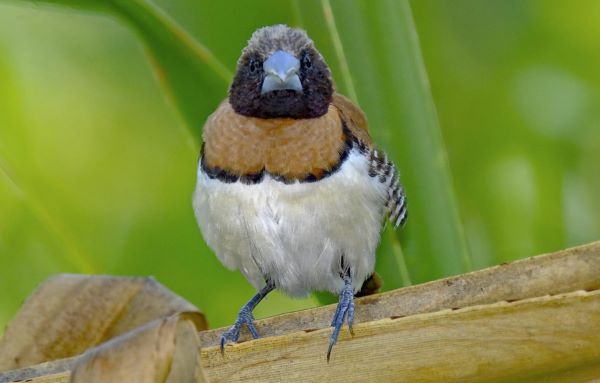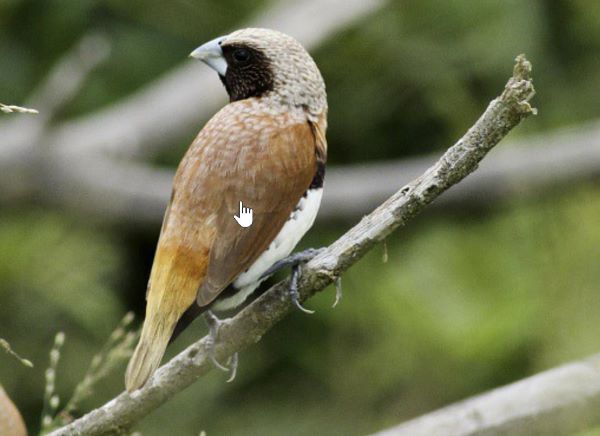Family: The chestnut-breasted mannikin (Lonchura castaneothorax) is a member of the family Estrildidae in the genus Lonchura.
Habitats: In dry seasons, it is spotted in the parched country, nevertheless near water; it also occurs in grassy wood cane fields, swamps, reed beds, mangroves, and cereal crops. Chestnut-breasted Mannikin is a typical finch. The birds are seen in flocks in groups of up to several hundred birds. They bunch into tight-flying packs, calling and executing all maneuvers in rapid unison. In addition, they eat, drink, rest, sleep, and sing in a group; fighting is infrequent and ritualized. They maintain bonds and coherence in flocks by “jingling” and gazing, but they never construct roost nests or preen one another; instead, they group to sleep in reed brakes.

Appearance: Both adult sexes are similar. The crown and back of the neck are flecked grey-brown. The back and wings are russet; the upper tail coverts and central tail feathers are straw-brown; and the outer tail is feather-brown. The face, chin, throat, and undertail coverts are black. The breast is pale chestnut with a lower edge bordered black (this band is sometimes narrower in females); the belly is white with flanks barred black. Eye brown. Bill blue-grey. Feet leaden-grey. The immature bird is olive-brown above and pale buff below, with a brown-buff breast.
Behavior: This social bird breeds in dense colonies with small nests only a few meters apart. Nest-building, incubation, and rearing resemble those of other Australian grass finches, with both sexes sharing all duties but only the female sleeping in the nest at night. Chestnut-breasted Mannikins inhabit banks of rank grasses and reeds on the margins of swamps, mangroves, and rivers around northern and eastern coastal Australia. There, they are locally nomadic, more so in the northwest than in the east. They have adapted well to cultivation, even becoming pests on crops.
Diet: The majority of their diet consists of partially ripe grass seeds, which they acquire by deftly clambering along seeding stems, one foot at a time; they land among the erect stems, reach out and grab a loaded spike, pull it down, and clasp it with one foot as they pluck the seeds. Finishing one spike, they begin on the next until four or five stripped stalks collect under their feet. At the start of the breeding season, they also catch flying termites on the wing. Drinking and scooping as the birds tilt their heads back to swallow. The species also enjoys millet Pannicum maximum, Saccharum robustum, bullrush millet Pennisetum typhoides, and paspalum grass Paspalum longifolium; therefore, local people call it the “barley bird.”.

Distribution: Along with its introduction to French Polynesia, the species is present in Australia, New Caledonia, Indonesia, and Papua New Guinea. In Australia, the bird is found in rank grasses, reeds fringing rivers, swamps, and mangroves around the coast, from Kimberleys, Western Australia, to Nowra, New South Wales. The bird is found in the drier regions of Papua New Guinea. It is not commonly observed in clearings and jungle roads where other munias, such as the grey-headed mannikin, are present.
Courtship: Mannikin finches court one another in a manner that varies from bird to bird, although it usually involves the male performing a song-and-dance ritual on grass stalks without holding any grass stems. He shakes his body and wipes his bill frequently while dancing up and down, ruffling the feathers on his head, breast, and rump. He also tips his bill downward and holds it wide open when whistling loudly. Approaching the female slowly, he stops singing and sits beside her. Both fluff their belly feathers, turn their tails towards each other, and bow several times. Copulation follows.
Vocalizations: Chestnut-breasted Mannikin calls a bell-like teet or tit in contact. However, the song consists of a 10- to 12-second toneless phrase of four-spaced segments: clicks, harsh notes in two series, and whistles in the evening.
Nesting and Breeding: Chestnut-breasted Mannikin nesting and breeding occur in all months, mainly in the summer and autumn. Nest spherical, compressed at sides, somewhat resembles a bottle with its neck sloping downwards; 130 mm long, 120 mm high, 90 mm wide; of dry blades of grass. The nest is lined with fine grass stems, built within 2 meters of ground, in dense clumps of grass and reeds, some worked into the nest, as well as bushes.
Eggs: The bird usually lays 4 to 6 eggs, white and oval, about 17 x 12 mm. The incubation period is about 12–13 days for both sexes. However young fledge in three weeks.
Other Names: The bird has several other names, i.e., Chestnut-breasted Finch, Bully Bird, Barley Bird, Barley Sparrow, Chestnut Finch, and Chestnut-breasted Munia.
Size: Chestnut-breasted Mannikin measures about 110–115 mm in length.
Similar Species: Interbreeding with the chestnut-breasted Mannikin can result in intermediate forms since the related yellow-rumped Mannikin, L. flaviprymna, lacks the chest bar and black face.
Races: There are about six races; probably two are found in Australia.
-
L. c. ramsayi found in southeastern Papua New Guinea.
-
L. c. castaneothorax found in eastern Australia.
-
L. c. boschmai found in the Lake Wissel area of Irian Jaya.
-
L. c. uropygialis found in Geelvink Bay in western Irian Jaya.
-
L. c. assimilis found in northern Australia.
-
L. c. sharpii is found in Hollandia, Irian Jaya, and Papua New Guinea.

The chestnut-breasted mannikin (Lonchura castaneothorax) is a member of the family Estrildidae in the genus Lonchura. Photo Credit: Graham Winterflood






